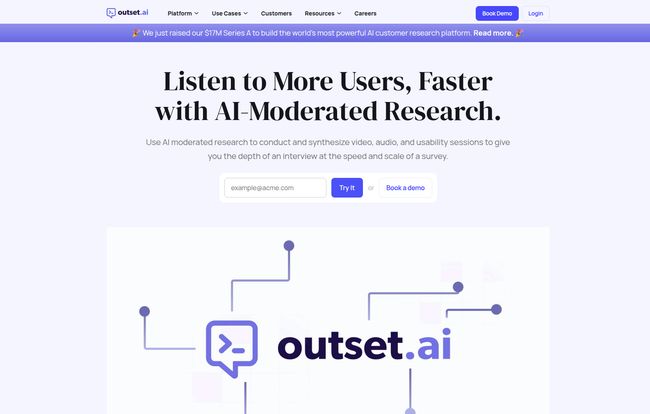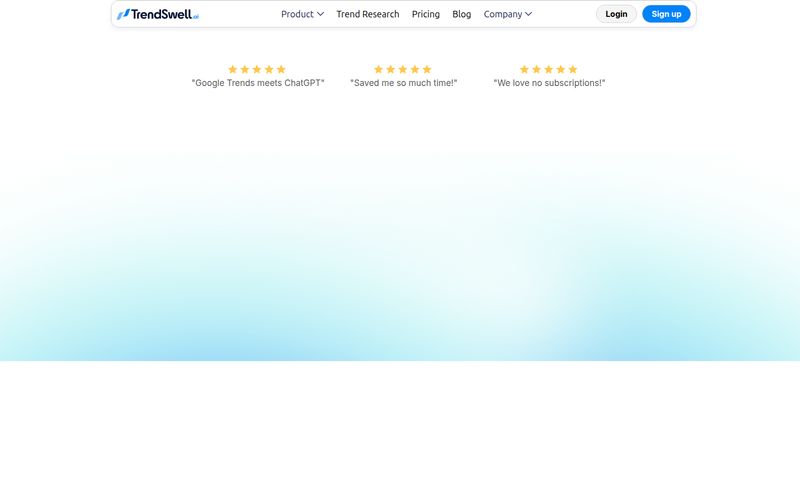I still have mild PTSD from a project back in 2018. We had to conduct 30 one-on-one user interviews for a major e-commerce client. Thirty. It took two of us nearly a month. The scheduling conflicts, the no-shows, the hours spent listening to recordings, the painstaking transcription... and then the real work began: staring at a wall of sticky notes, trying to find a glimmer of a pattern in a sea of quotes. It was brutal. We got great insights, but at what cost to our sanity and timeline?
Ever since then, I've been on the lookout for a better way. We’ve seen AI creep into copywriting, image generation, and SEO, but the nuanced world of qualitative research felt... untouchable. Too human. Well, maybe not anymore. I’ve been playing around with a platform called Outset.ai, and it's making me question everything I thought I knew about the limits of AI in research.
So, What on Earth is Outset AI?
Put simply, Outset is an AI-moderated research platform. Instead of a human researcher asking questions over a video call, Outset uses a sophisticated AI, powered by the same kind of LLM technology behind things like ChatGPT, to conduct the interview. It can chat with participants via video, audio, or even text, following a discussion guide you provide.
But here's the kicker: it can do this with hundreds of participants simultaneously. Let that sink in. The logistical nightmare of coordinating even a dozen interviews just... vanishes. It’s designed to take the most time-consuming parts of qualitative research—the actual conducting and synthesizing—and condense a month's work into a matter of hours. Honestly, it sounds like science fiction, but the results are pretty compelling.

Visit Outset
The Features That Actually Matter
Okay, so it's a cool concept. But as we all know in the marketing and product world, a cool concept doesn't always translate into a useful tool. A platform can have a million features, but only a few truly change your workflow. Here’s what stood out to me about Outset.
The AI Moderator: Your New Research Assistant
This is the core of the whole thing. The AI isn't just a dumb script-reader. It can ask follow-up questions, probe for more detail, and create a surprisingly natural conversation flow. What’s really neat is that you can customize the AI’s persona. Need a super friendly and casual vibe for a Gen Z-focused app? Done. Need a more formal, professional tone for a B2B SaaS tool? You can do that too. It’s a level of control I didn't expect.
And it's multimodal. Participants can interact in whatever way feels most comfortable, whether that's a full-on video chat, a voice-only conversation, or just typing out their answers. This flexibility can seriously boost completion rates.
From Raw Data to Actionable Insights in Hours
For me, this is the real magic. After the interviews are done, the AI doesn't just hand you a pile of transcripts. It gets to work synthesizing everything. Everything. It identifies key themes, pulls out representative quotes, and even generates highlight reels. Anyone who has spent a full day pulling video clips for a presentation to stakeholders knows how valuable this is. It turns raw, messy human conversation into a digestible report that you can actually use to make decisions. That is a massive, massive time-saver.
Scaling Your Research Without Scaling Your Team
The platform isn't just for conversational interviews. It handles unmoderated testing with screen sharing, which is fantastic for usability studies. You can watch how users actually interact with your site or prototype, at a scale that's usually reserved for quantitative analytics tools. Plus, they offer flexible participant recruitment. You can bring your own users (from your email list, for example) or tap into their network to find the right people. It democratizes high-level research for teams that don't have a dedicated research department or a massive budget.
The Good, The Bad, and The AI
No tool is perfect, right? Let's get real about where Outset shines and where you might want to pause and think. I'm an optimist, but also a pragmatist who's been burned by overhyped tech before.
The Good Stuff (Why I'm Genuinely Excited)
The advantages are pretty clear. The speed is the most obvious one; going from project kickoff to insights in a few days instead of a few weeks is a total game-changer. The scale is a close second. Getting qualitative feedback from 150 people instead of just 10 gives you so much more confidence in your findings. It starts to blur the line between qual and quant in a really interesting way. And naturally, when you save that much time, you're also saving a ton of money on man-hours and recruitment logistics. Teh cost-benefit analysis here is pretty easy.
The... Considerations (Let's Be Honest)
Now, I know what the purists are thinking, because I was thinking it too. Can an AI really replace a human researcher? In my opinion, not entirely. A skilled human moderator can pick up on a hesitant sigh, a subtle eye-roll, or a spark of excitement that an AI might miss. There's a layer of human connection and empathy that code can't replicate, at least not yet. There's also the ever-present concern of AI bias. The models are trained on vast datasets, and if those datasets have inherent biases, the AI's analysis could reflect that. Finally, the quality of your output is directly tied to the quality of your input. A poorly designed discussion guide will lead to poor results, AI or not. This isn't a magic wand; it's a force multiplier that still requires a skilled hand to guide it.
Who Is This For? (And Who Should Stick to the Old Ways?)
So who should be booking a demo right now? I see a few key groups.
- Market Researchers: For large-scale concept testing, brand perception studies, or ad testing, this is a no-brainer. The ability to get deep feedback from a huge sample, fast, is invaluable.
- UX Researchers & Product Teams: This is perfect for rapid, iterative testing. Get quick feedback on new features, run usability tests on a prototype, or conduct exploratory research to inform your roadmap. It fits perfectly into an agile workflow.
- Startups & Lean Teams: If you don't have a dedicated researcher on staff, Outset could be a godsend. It gives you access to powerful insights without the overhead of hiring a specialist or expensive agency.
Who should be cautious? If you're researching a highly sensitive topic (like personal trauma or health issues) or working with vulnerable populations, the empathy and trust-building of a human researcher is probably non-negotiable. For those very specific, delicate conversations, the old way is still the best way.
What About the Price Tag?
Ah, the million-dollar question. As of writing this, Outset doesn't list their pricing publicly on their site. This is pretty common for B2B SaaS platforms in this space. It likely means they have a tiered pricing model based on the number of participants, features you need, or seats for your team. Your best bet is to do what their website encourages: book a demo. That's the only way to get a real quote tailored to your specific needs.
Frequently Asked Questions about Outset AI
I've gotten a few questions from colleagues about this, so here are some quick answers.
Can Outset replace my entire research team?
No, and it shouldn't. Think of it as a powerful new tool in your team's toolkit. It automates the repetitive, time-consuming tasks, freeing up your human researchers to focus on strategy, interpreting the nuances of the AI's findings, and presenting insights to stakeholders.
How does participant recruitment work?
You have options. You can bring your own participants (often called BYO) by sending them a link, or you can use Outset's network to source participants based on specific demographic and psychographic criteria.
How is this different from a survey tool like SurveyMonkey?
It's all about the 'why'. Surveys are great for quantitative data—the 'what', 'where', and 'when'. Outset is for qualitative data—the deep, conversational 'why' behind user behaviors. It's an interview, not a questionnaire.
Is the AI's analysis 100% reliable?
It's incredibly powerful, but I'd always recommend a human review. The AI does an amazing job of the first 90% of synthesis, finding themes and pulling quotes. But a smart researcher should always do a final pass to add context and ensure no subtleties were missed.
What kind of studies is Outset best for?
It's incredibly versatile. The website mentions everything from market and brand research to more specific UX tasks like usability tests, concept tests, and exploratory research. If you need to understand user motivations and opinions at scale, it's likely a good fit.
My Final Take on Outset
Look, traditional qualitative research isn’t going away entirely. But tools like Outset represent a major shift in how we work. It’s not about replacing humans, it's about augmenting them. It’s a tool that tackles the two biggest bottlenecks in research: time and scale.
For years, we’ve had to choose between getting rich, deep insights from a small group of people, or shallow, quantitative data from a large group. Outset promises a world where you don't have to choose. You can have both. And in my book, that's not just an evolution; it's a revolution. It's a sign of where the industry is heading, and honestly, I'm excited to see where it takes us.
Reference and Sources
- Outset Official Website
- Qualitative Research: What It Is, How to Conduct It, & How to Analyze It by Nielsen Norman Group



